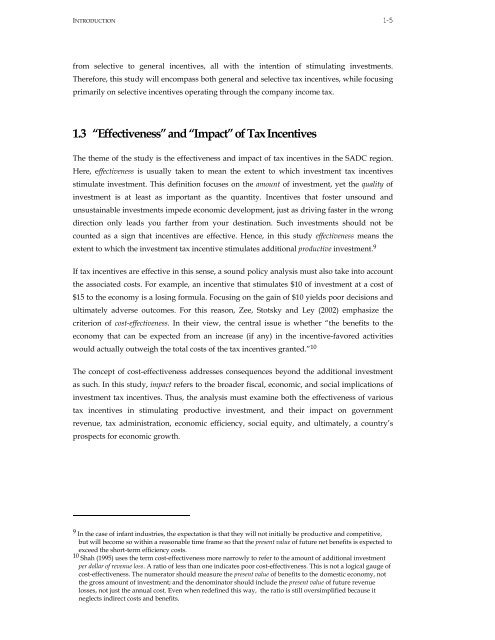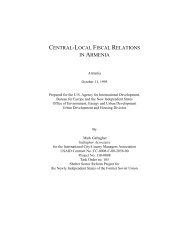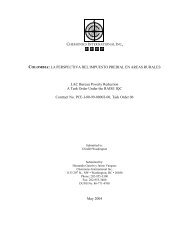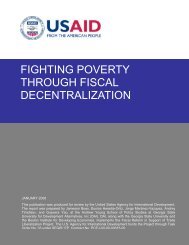Effectiveness and Economic Impact of Tax Incentives in the SADC ...
Effectiveness and Economic Impact of Tax Incentives in the SADC ...
Effectiveness and Economic Impact of Tax Incentives in the SADC ...
You also want an ePaper? Increase the reach of your titles
YUMPU automatically turns print PDFs into web optimized ePapers that Google loves.
INTRODUCTION 1-5<br />
from selective to general <strong>in</strong>centives, all with <strong>the</strong> <strong>in</strong>tention <strong>of</strong> stimulat<strong>in</strong>g <strong>in</strong>vestments.<br />
Therefore, this study will encompass both general <strong>and</strong> selective tax <strong>in</strong>centives, while focus<strong>in</strong>g<br />
primarily on selective <strong>in</strong>centives operat<strong>in</strong>g through <strong>the</strong> company <strong>in</strong>come tax.<br />
1.3 “<strong>Effectiveness</strong>” <strong>and</strong> “<strong>Impact</strong>” <strong>of</strong> <strong>Tax</strong> <strong>Incentives</strong><br />
The <strong>the</strong>me <strong>of</strong> <strong>the</strong> study is <strong>the</strong> effectiveness <strong>and</strong> impact <strong>of</strong> tax <strong>in</strong>centives <strong>in</strong> <strong>the</strong> <strong>SADC</strong> region.<br />
Here, effectiveness is usually taken to mean <strong>the</strong> extent to which <strong>in</strong>vestment tax <strong>in</strong>centives<br />
stimulate <strong>in</strong>vestment. This def<strong>in</strong>ition focuses on <strong>the</strong> amount <strong>of</strong> <strong>in</strong>vestment, yet <strong>the</strong> quality <strong>of</strong><br />
<strong>in</strong>vestment is at least as important as <strong>the</strong> quantity. <strong>Incentives</strong> that foster unsound <strong>and</strong><br />
unsusta<strong>in</strong>able <strong>in</strong>vestments impede economic development, just as driv<strong>in</strong>g faster <strong>in</strong> <strong>the</strong> wrong<br />
direction only leads you far<strong>the</strong>r from your dest<strong>in</strong>ation. Such <strong>in</strong>vestments should not be<br />
counted as a sign that <strong>in</strong>centives are effective. Hence, <strong>in</strong> this study effectiveness means <strong>the</strong><br />
extent to which <strong>the</strong> <strong>in</strong>vestment tax <strong>in</strong>centive stimulates additional productive <strong>in</strong>vestment. 9<br />
If tax <strong>in</strong>centives are effective <strong>in</strong> this sense, a sound policy analysis must also take <strong>in</strong>to account<br />
<strong>the</strong> associated costs. For example, an <strong>in</strong>centive that stimulates $10 <strong>of</strong> <strong>in</strong>vestment at a cost <strong>of</strong><br />
$15 to <strong>the</strong> economy is a los<strong>in</strong>g formula. Focus<strong>in</strong>g on <strong>the</strong> ga<strong>in</strong> <strong>of</strong> $10 yields poor decisions <strong>and</strong><br />
ultimately adverse outcomes. For this reason, Zee, Stotsky <strong>and</strong> Ley (2002) emphasize <strong>the</strong><br />
criterion <strong>of</strong> cost-effectiveness. In <strong>the</strong>ir view, <strong>the</strong> central issue is whe<strong>the</strong>r “<strong>the</strong> benefits to <strong>the</strong><br />
economy that can be expected from an <strong>in</strong>crease (if any) <strong>in</strong> <strong>the</strong> <strong>in</strong>centive-favored activities<br />
would actually outweigh <strong>the</strong> total costs <strong>of</strong> <strong>the</strong> tax <strong>in</strong>centives granted.” 10<br />
The concept <strong>of</strong> cost-effectiveness addresses consequences beyond <strong>the</strong> additional <strong>in</strong>vestment<br />
as such. In this study, impact refers to <strong>the</strong> broader fiscal, economic, <strong>and</strong> social implications <strong>of</strong><br />
<strong>in</strong>vestment tax <strong>in</strong>centives. Thus, <strong>the</strong> analysis must exam<strong>in</strong>e both <strong>the</strong> effectiveness <strong>of</strong> various<br />
tax <strong>in</strong>centives <strong>in</strong> stimulat<strong>in</strong>g productive <strong>in</strong>vestment, <strong>and</strong> <strong>the</strong>ir impact on government<br />
revenue, tax adm<strong>in</strong>istration, economic efficiency, social equity, <strong>and</strong> ultimately, a country’s<br />
prospects for economic growth.<br />
9 In <strong>the</strong> case <strong>of</strong> <strong>in</strong>fant <strong>in</strong>dustries, <strong>the</strong> expectation is that <strong>the</strong>y will not <strong>in</strong>itially be productive <strong>and</strong> competitive,<br />
but will become so with<strong>in</strong> a reasonable time frame so that <strong>the</strong> present value <strong>of</strong> future net benefits is expected to<br />
exceed <strong>the</strong> short-term efficiency costs.<br />
10 Shah (1995) uses <strong>the</strong> term cost-effectiveness more narrowly to refer to <strong>the</strong> amount <strong>of</strong> additional <strong>in</strong>vestment<br />
per dollar <strong>of</strong> revenue loss. A ratio <strong>of</strong> less than one <strong>in</strong>dicates poor cost-effectiveness. This is not a logical gauge <strong>of</strong><br />
cost-effectiveness. The numerator should measure <strong>the</strong> present value <strong>of</strong> benefits to <strong>the</strong> domestic economy, not<br />
<strong>the</strong> gross amount <strong>of</strong> <strong>in</strong>vestment; <strong>and</strong> <strong>the</strong> denom<strong>in</strong>ator should <strong>in</strong>clude <strong>the</strong> present value <strong>of</strong> future revenue<br />
losses, not just <strong>the</strong> annual cost. Even when redef<strong>in</strong>ed this way, <strong>the</strong> ratio is still oversimplified because it<br />
neglects <strong>in</strong>direct costs <strong>and</strong> benefits.











